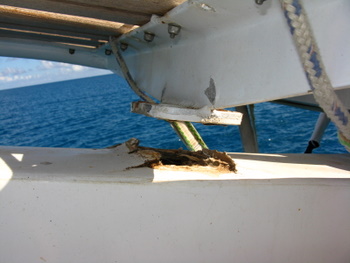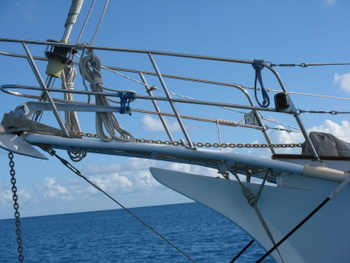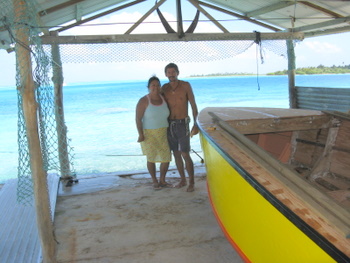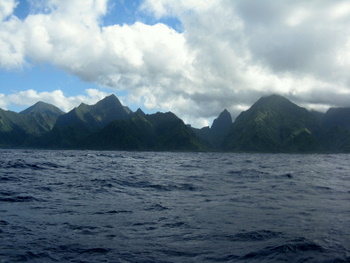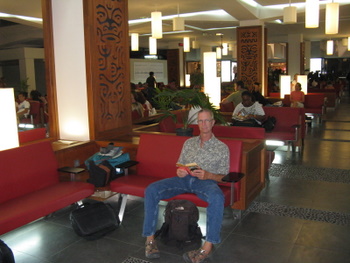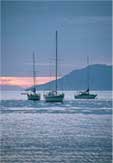
Current Location
(enter callsign KG6NNZ)
Logbook: Tuamotu Archipelago and Tahiti - August to September 2010
| Our last ten days in the Marquesas
Islands were spent waiting patiently for a weather window to sail to the Tuamotus.
Taiohae Bay on Nuku Hiva wasn't such a bad place to be "stuck" however, and
during this time, we got further acquainted with some of the locals, did
some excellent hikes and hung out with cruising friends. By the time we finally left, we were sad to say good-bye
to these beautiful islands and friendly Marquesan people.
Our next destination was the Tuamotu Archipelago, a group of 78 island atolls, which lie between the Marquesas and Society Islands of French Polynesia. We left Taiohae Bay on Nuku Hiva and set sail for Fakarava atoll. At this point, we were excited about not only our next destination but also our revised cruising plans. Our original plan for this year was to sail to New Zealand by mid-November. That plan assumed that we would only spend 90 days in French Polynesia, which is the time limit this country imposes on visitors. We had just spent six weeks (or half of our allotted time for French Polynesia) in the Marquesas, and there were still two more island groups we wanted to see - the Tuamotus and Society Islands. In order to get more time in French Polynesia, we would need to leave the country for at least 90 days, and upon our return, the clock would start over for another 90 days. Ironically, the boat could stay, but we needed to leave. To that end, we located and reserved a spot for Slip Away in a marina in Tahiti, and we bought airline tickets to fly back to the USA for an extended visit with our families and friends. So for now, we had six more weeks to sail through these islands, and we'd have more time when we got back. |
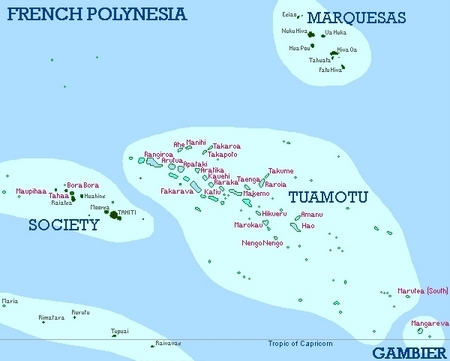 |
Tuamotu Archipelago
All but two of the 78 islands in the Tuamotu Archipelago are atolls - rings of islands and coral which surround a central lagoon. The Tuamotus are the largest group of coral atolls in the world, and they are scattered across an area of ocean 370 miles wide and 930 miles long (600 km by 1500 km).
In contrast to the mountainous Marquesas, the Tuamotus are low-lying. Prior to GPS, the Tuamotus were rarely visited by cruising boats because navigation among them was difficult. Although GPS has made navigation easier, these islands still come with their challenges. In most instances, visiting these atolls involves entering the lagoon through a pass, or break in the ring of islands or coral, and water flows rapidly through these passes with the changing tides. It is recommended to try to navigate the passes at slack water - that short period of time (maybe 20 to 30 minutes) between incoming and outgoing tides. Figuring out the exact timing of slack water involves a bit more than just checking the tide tables, however. The tide tables used by most cruisers give tides for only a couple of the atolls - Rangiroa in the north and Hao in the south, and one has to take an educated guess at the ones in between. Also, in periods of sustained strong southeast winds (which we were experiencing), additional water is blown over the reef into the lagoon, and sometimes an atoll can go for a few days with no incoming tide. So, the best advice we received was to get to the pass before the anticipated slack water, look at the pass, wait until the water in the pass didn't look so rough, and then proceed.
The big attraction for us in the Tuamotus is the diving and snorkeling. We visited the atoll of Rangiroa on our honeymoon in 1999, and we thoroughly enjoyed the diving there. Although we wouldn't get to Rangiroa during this trip through the Tuamotus, we are planning to go there when we return in 2011. For this year, we had about a month to do some exploring before heading to Tahiti, and we were planning to visit the atolls of Fakarava and Toau.
Passage from Nuku Hiva, Marquesas, to Fakarava Atoll, Tuamotus (August 5-9, 576 nm, 4 days + 1½ hours). We left Taiohae Bay mid-morning on August 5, and although seas were a bit rough when we first exited the bay, they calmed down shortly thereafter. With 10-15 knots of east wind, we enjoyed a nice leisurely first day on passage sailing south with the wind on our beam. The next day, the winds picked up to 15-20 knots, and the seas got rougher. At one point, a large wave broke onto our port deck and splashed a few gallons of water into our cockpit, soaking our cockpit cushions and pillows and even sending a bit of water down below. The water came in despite our having the curtains of our cockpit enclosure closed and secured. This was only the second time in our six years of cruising that we got a significant amount of water in the cockpit, and we weren't happy campers having our cockpit gear drenched in salt water while still a couple of days from our destination. The winds eased a bit early the next morning, and the rough seas abated, so our third day on passage was another day of excellent sailing. These conditions lasted about 24 hours, when we ran into a stalled cold front. When we checked in on the SSB radio net that morning, we were having a lovely sail, but we learned that a weak cold front had stalled in the area which lay just ahead of us on our course. We were sailing along with sun and blue skies, but we could see the telltale clouds ahead of us. When we sailed into the cold front, we encountered rain squalls, and the winds increased to 20-25 knots. Of course, once the weather turned bad, we finally got a hit on our fishing line. Rich went out on the back deck in the pouring rain, fought the fish for about 20 minutes, and finally brought a nice-sized tuna up next to the boat. However, our bad luck with fishing continued, as at that point, the leader broke and we lost both the fish and the lure. We won't repeat the words that came out of Rich's mouth when that happened! After hitting the cold front, the wind veered to the southeast, putting it forward of our beam and making for an uncomfortable ride. We sailed for several hours beating into the strong winds, with large waves crashing into our bow and splashing across the whole boat (but for the most part we were dry in the cockpit). Although we had anticipated that the winds would turn southeast in the latter part of our trip, we had not expected them to be quite so strong. We were nearing our destination (the south end of the Fakarava atoll), but we were having difficulty pointing Slip Away high enough to sail around Raraka atoll, which stood in our path. Although we would have preferred to make landfall at the south end of Fakarava, we decided to change course and head to the north end of Fakarava, a decision which not only avoided an encounter with Raraka atoll, but also moved the wind further aft on our beam and made for a much more comfortable ride.
Normally, after a four-day passage, we're just happy to arrive at our destination in daylight, since it's not always easy to accurately predict the winds and currents and thus our boat speed. This destination was doubly difficult because we needed to arrive in time for a small window of slack water to enter the pass. Instead of arriving a little early to have a look at the pass, we arrived about 30 minutes late. The pass looked rough, but since we had never entered one of these passes before, we weren't sure exactly what it should look like. Our cruising guide told us that this was a wide and easy pass, and one didn't necessarily have to navigate it exactly at slack water. We saw several small powerboats in the middle of the pass - boats from scuba shops - so we figured it was safe to proceed. We made it safely through the pass, but it was a rough ride. There was a knot or so of current running into the lagoon, and the strong southeast winds were opposing the flow, which made for some steep waves. We buried the bow several times, but we made it through. Our friends Korey & Clara on Comfort Zone arrived at the pass about 15 minutes behind us. They watched us go through, and we called them on the radio when we were through the rough stuff. We suggested they wait and see if the pass got a bit calmer. They waited outside for about a half an hour, saw no improvement, and decided to proceed. They, too, had a rough trip but made it through safely.
As we motored toward the anchorage off the village of Rotoava, we noticed some water in the bilge, which was not a good sign. Rule # 1 in boating is to keep the water on the outside of the boat! The water level was not rising, but we were concerned about where it came from since our bilges are normally dry. When we dropped the anchor, Rich immediately saw the problem. Our bowsprit was bent, and the staysail had pulled out of the underlying fiberglass. There was a hole in the bow of our boat. Big problem! We're not sure how or why this happened, but after further examination, it appears to us that the aluminum bowsprit was not built strong enough (especially for two heavy anchors hanging off the end of it). We were grateful that this didn't all come apart while we were on passage in rough seas. We would need to make some temporary repairs and secure the rigging before moving on. Fortunately, Rich has excellent "MacGyver" skills. Over the next few days, we took down the staysail and stored it on the side deck, temporarily covered the hole (gotta love duct tape!), and secured the bowsprit with some straps. We would have to locate permanent repairs in Tahiti.
|
|
|
Rotoava, North Fakarava (August
9-22).
Fakarava is the second largest atoll in the Tuamotus. It has a rectangular shape and is 32 miles long and 15 miles wide (51.5 km by 24 km). In the northeast corner of Fakarava is the village of Rotoava, where a few hundred locals reside, and there are a couple of small stores, a bakery, some tourist bungalows, a restaurant or two, a couple of dive shops and wi-fi internet in the anchorage.
After our four-day passage and feeling a bit discouraged by our broken boat, we were eager to go ashore. We got off the boat that afternoon, went for a long walk and did some beachcombing with Korey & Clara from Comfort Zone. We checked out the magasins (small stores), found the bakery and picked up a couple of loaves of French bread, and also visited the local dive shop. We immediately liked Fakarava - white sand, beautiful blue water, friendly people and a laid-back atmosphere.
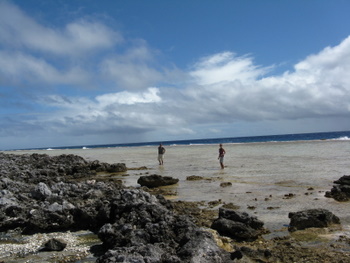 Korey & Clara from Comfort Zone beachcombing on Fakarava |
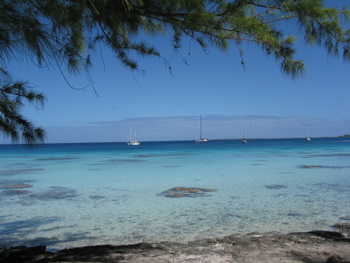 Slip Away anchored at North Fakarava |
Although we often like to scuba dive on our own, the best dive sites in North Fakarava were about five miles from the anchorage. That was too far to go in our dinghy, so we booked a couple of dives with the Te Ava Nui Dive Shop. The first dive we did here was a drift dive through the pass, and it was nothing short of spectacular. The pass was teeming with fish - grouper, parrotfish, wrasse, butterflyfish, surgeonfish, sharks - incredible! We also did a dive along the outside wall of the atoll, and although not as spectacular as the first one, it too was very good with healthy corals and plentiful fish life.
We ended up spending almost two weeks in the North Fakarava anchorage. The French bread from the local bakery was the best we'd found in French Polynesia so far, and Rich went ashore most mornings to get it fresh from the oven (and he usually also picked up a couple of chocolate croissants) . We did have a few days when we were bread-less, though, because the supply ship came in and didn't bring flour for the bakery, so they ran out. Everyone on the island was in better spirits when a few days later, the shipment of flour arrived. We visited the Hinano Pearl Farm, where they farm black pearls. The owner Gunther, a German guy, gave us a tour, and we couldn't resist buying just a few of the beautiful black pearls. In addition to diving, the snorkeling around the many coral heads inside the lagoon became a daily activity. There were only a couple of restaurants in Fakarava, one of which came highly recommended, and we went there one day for lunch. We sat on a porch overlooking the beautiful waters of the lagoon and were served by a Frenchman wearing a pareo tied around his waist (no shoes and no shirt were no problem!). The "poisson cru" at that restaurant was outstanding! Korey and Clara on Comfort Zone decided to venture down to the south end of Fakarava, which could be reached by staying inside the lagoon. We thought about doing that too, but ended up staying put because we were not feeling particularly motivated to move on. Ben & Annemiek on Blue Penguin, and Steve & Heather on Kate came into the anchorage at Rotoava, and we snorkeled and shared a few cocktails with them.
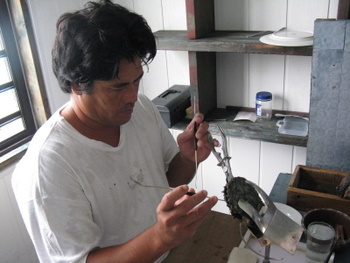 Local "pearlmaster" harvesting the black pearl and re-seeding the oyster |
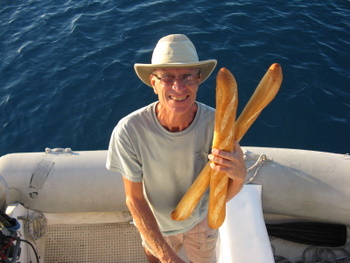 Rich returns with baguettes from his early morning run ashore |
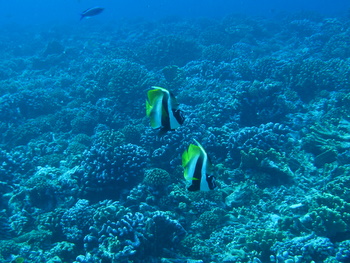 A couple of masked bannerfish swimming along the coral gardens |
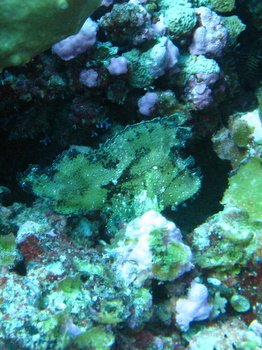 Can you see the leaf fish in this photo? |
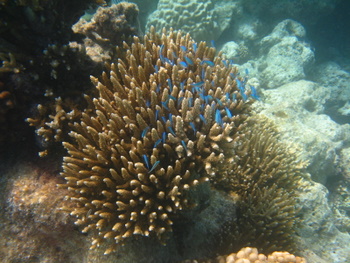 Blue damselfish swimming in the coral branches |
Passage from North Fakarava to Anse Amyot, Toau (August 22, 43 nm, 7½ hours). From Fakarava, we were headed to Toau, which was a day sail, but we were up before dawn to get an extra early start for it. According to our tide tables and calculations, slack water at the pass would occur about 8:30 a.m., and it would take us about 45 minutes to get there from the anchorage. We wanted to allow ourselves some extra time in case we had any issues with our anchor or anchor chain being fouled on coral, which is a problem many cruisers run into in these islands. We do our best to keep clear of coral when anchoring, but there are "bommies" (coral heads) scattered throughout the lagoon, and we could not see the bottom. We could occasionally hear our anchor chain grinding on something hard, so we knew the coral was there.
Weighing anchor that morning started out well. Every once in a while the chain would catch on something, but we used the engine to maneuver the boat back and forth or sideways, and it freed up. Unfortunately, when we got to the anchor, it was stuck, and none of our maneuvers could get it free. One of us needed to get into the water and assess the situation, and Jan donned mask, snorkel and fins and jumped in. Our anchor was in about 35' of water, and although she cannot free dive that deep, she could dive down far enough to see the anchor was wedged under a coral head. Rich got out a scuba tank and our 40' hookah hose, and Jan put on her weight belt and dove down to free up the anchor. With the tank on our deck, the hookah hose was just long enough for her to reach the anchor. She freed up the anchor, surfaced, and told Rich to raise the anchor. When he tried to do so, the anchor was still stuck. Jan dove down again, and saw that the anchor had drifted and got caught on a different coral head, so she freed it up again. We repeated this exercise a couple more times, and finally the anchor stayed free, Rich brought it on deck, and Jan climbed back on board. The stuck anchor cost us about 40 minutes of time but since we had gotten our early start, there was no problem.
Our day got much better after that. We arrived at the pass early, and conditions were calm. There was a 1½ knot current running out of the pass, and the winds were blowing from the same general direction, so there were none of those steep square waves. There was a bit of unsettled water in the middle of the pass, so we stayed to the right (on the east side of the pass) and avoided it. This time, the pass was a piece of cake. And, once outside the pass, it was a beautiful sunny day, and sailing conditions were excellent. With 15-20 knots of wind on our beam, we raised our mizzen, unfurled our jib, and set our course for Anse Amyot, on the atoll of Toau. Chantal & Fredy on the Swiss catamaran Micromegas departed shortly after us, and since catamarans are faster than monohulls, they passed us by, but we had a nice opportunity to take pictures of one another along the way.
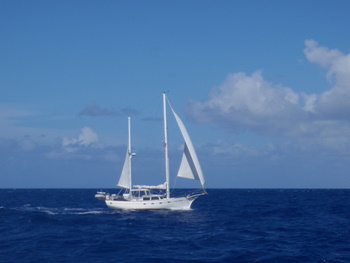 Slip Away underway to Anse Amyot |
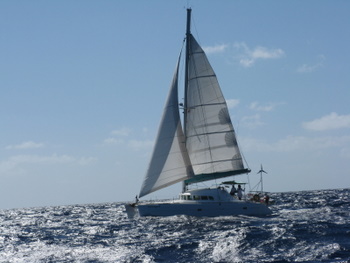 Micromegas passing us by |
Anse Amyot, Toau (August 22 to September 6).
| Anse Amyot is a cove (often described as a "cul de
sac") on the northwest side of the atoll of Toau, and we did not have to enter a
pass to get into the anchorage. Also, there are mooring balls installed in
this anchorage, so one does not have to worry about fouling their anchor on
coral heads. We arrived mid-afternoon, and Larry on Tao 8 helped us secure
Slip Away to the mooring ball.
Anse Amyot is a popular anchorage among South Pacific cruisers. It's a beautiful cove with excellent snorkeling and diving. A local couple, Gaston & Valentine, live on one of the islands here and are very welcoming to cruisers, but other than that, it's pretty remote. The closest town is Rotoava on Fakarava, so one needs to have ample provisions on board if they want to hang out at Anse Amyot for a while. We had heard that bringing a few fresh provisions from Rotoava to Valentine & Gaston is always appreciated, so we picked up some fresh fruits and veggies and a few loaves of bread for them before we departed. Although that doesn't sound like a lot, prices of fruits and veggies are extremely high in the Tuamotus, so we spent a good amount of money. Bartering is a popular form of payment, and in return for our good deed, they gave us a nice piece of mahi mahi, free mooring for a week, and a free meal at the cruiser dinner that they occasionally host. When there are lots of cruisers in the area, Valentine & Gaston host a dinner usually once per week, and attending and buying dinner gets one free mooring. If one chooses not to attend the dinner, the mooring rate is $5 per day. |
|
Our friends on Blue Penguin and Kate arrived in Anse Amyot a day or so before us and were planning a bonfire on the beach the evening we arrived. There were six or seven boats in Anse Amyot at the time, everyone was invited and most everyone came. It was a fun party - grilling our mahi mahi over the fire, sharing a potluck of side dishes, drinking a few beers and then a bit of entertainment with hermit crab races. Good times!
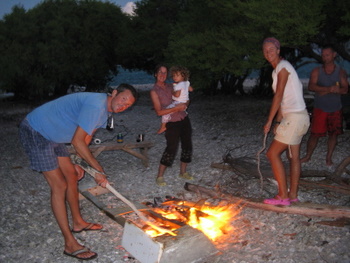 Ben & Annemiek (Blue Penguin) stoking the fire. Angie (Tao 8) holding one of the kids from Sel Citron |
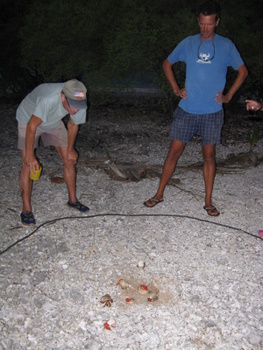 Rich and Ben rooting on their hermit crabs. |
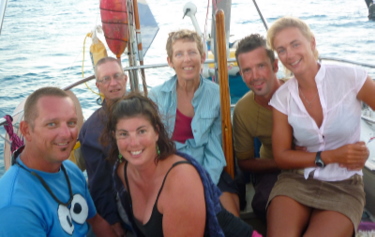 Happy Hour on Blue Penguin with Ben & Annemiek, Steve & Heather from Kate and the two of us. |
The rest of the crowd in Anse Amyot departed a few days later, but we stayed on for a couple of weeks. We paid for our second week on the mooring with a half bottle of olive oil, some ibuprofen and about a half-liter of Jack Daniels (which made Valentine very happy!). For much of that time, we had the anchorage to ourselves. A couple other boats came and went, but none stayed more than a night or two. For us, the attraction of this anchorage was easy access to some excellent dive sites. Other cruisers who had visited Anse Amyot prior to us provided waypoints for several good sites. Some of these dive sites were a mile or so away from the anchorage, along the outside wall of the atoll. They were reachable by dinghy and we could dive them on our own; however, when dive sites are that far away, we normally like to dive with a buddy boat in case there's any problems such as the dinghy motor not wanting to start. We didn't have anyone to buddy-up with, but we always let Gaston & Valentine know when we were headed out and where, asking them to come look for us if we weren't back in a couple of hours (and we always let them know when we got back). We also took our handheld VHF radio, and they have one too, so we could call if we had a problem. Fortunately, they never had to come look for us, and we never had to call for help.
On one of the dinghy rides out to a dive site, we saw some whales about a half mile from us, and Rich was thrilled when he saw one of the whales breach. Unfortunately, Jan had just looked down at the GPS to check our location when it happened, and she missed it, only seeing the end of the splash.
The dive sites were really beautiful. Fish life was good, and the corals were healthy. We were surprised that we only found hard corals in the Tuamotus - no soft corals, fans or sponges - and can only conclude that it is due to some fluke of nature that soft corals and sponges don't proliferate in this area. We took lots of photos and spent a lot of time trying to identify the fish we saw. Our friend Kathy on Jumbie described diving in the Pacific as seeing many of "our old Caribbean friends, only in different costumes and fancy dress" - quite an appropriate description. The grouper, triggerfish, butterflyfish, angelfish, etc., had the same basic shape as their cousins in the Caribbean, but they were different colors and patterns. And, there were some varieties of fish that we'd never seen before. We had lots of new names to learn.
In addition to the scuba diving, the snorkeling was fantastic, and one didn't have to go far at all to enjoy that. We could just jump in the water from Slip Away and swim to the reef off our starboard side. If we timed the tides right, the water was crystal clear, and we found lots of fish life in less than 10 feet of depth. One day, when the weather was too lively to venture far in the dinghy, we decided to dive in the anchorage. It was a shallow dive - maximum 25' - but we saw lots of good stuff, including a great octopus that raised himself out of a hole in the coral to take a good look at us.
.jpg) Slip Away moored at Anse Amyot (photo taken by Heather on Kate) |
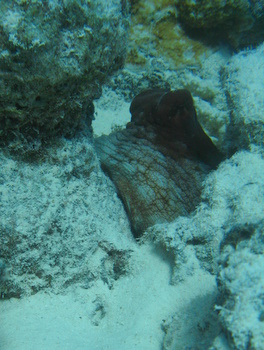 The octopus under our boat |
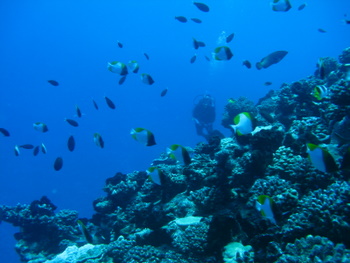 Jan admiring a school of pyramid butterflyfish |
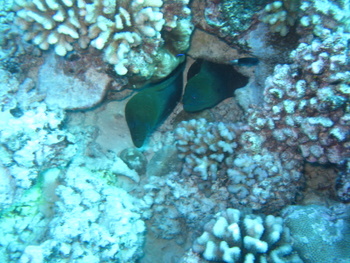 Two green morays together in a hole - the first time we ever saw this - must have been mating season |
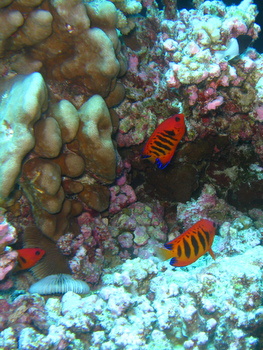 Flame angelfish - very small and very shy |
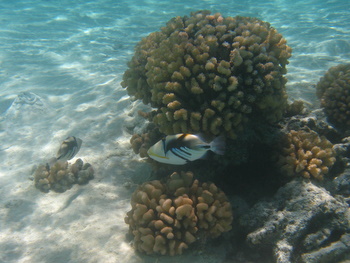 Picasso triggerfish |
When we were ready to depart Anse Amyot for Tahiti, we once again found ourselves waiting for weather. During our last few days, we had a fair amount of squalls and winds blowing 25-30 and sometimes up to 35 knots. We were not in a time crunch, so we stayed put until the weather improved.
| Passage from Anse Amyot, Toau, Tuamotus, to
Port du Phaeton, Tahiti (September 6-8, 235 nm, 43½ hours). When the weather forecast improved, we were on our way to Tahiti. We left Anse Amyot about an hour before sunset, with the winds blowing 18-22 knots
aft of our beam.
Since it was approaching nightfall, and we thought we might get some squalls
that evening, we decided to start the passage with just our headsail. That way, if
we were hit by a strong squall, we didn't have too much sail up, and we could
easily roll up the headsail. When we first left the anchorage, the seas were
blocked by the atoll, and with a 1½ knot current giving us a push, we were
flying along at 6.5 to 7 knots on flat seas - very nice! A couple of hours
later, we were in lumpy seas, with a 4-6 foot mixed swell coming from the south
and southeast.
Overall, it was a good passage to Tahiti. We had a few squalls the first night, but the winds never went over 25 knots. By mid-afternoon the next day, winds were down to 13 knots, and we raised the main and mizzen sails. That night, again in anticipation of squalls, we doused the mizzen and put a reef in the main, but we had no squalls that night. With winds in the mid-teens just aft of the beam and seas running about three feet, it was great sailing. When the sun came up the next morning, we could see the island of Tahiti shrouded in clouds. There is a barrier reef surrounding Tahiti with several breaks through which boats can pass, but no strong currents. Winds picked up into the low 20's as we were approaching our destination of Port du Phaeton, but it was an easy entrance, and once inside the barrier reef, the seas were almost flat calm. |
|
| Port du Phaeton, Tahiti (September 8 to 17).
The island of Tahiti is made up of two land masses - Tahiti Nui and Tahiti Iti -
joined by an isthmus. Port du Phaeton penetrates the isthmus on the south
side of the island forming a very protected bay and the best hurricane hole in Tahiti. Tahiti Nautic Center, the marina where we planned to leave
Slip Away during our trip back to the U.S., is located in
Port du Phaeton.
We had two weeks until our flight back to the States, but we arrived early to take a look at the marina, as well as make sure everything was set for our reservation. There is a nice anchorage in the bay in front of the marina, and after dropping our hook, we dinghied in to Tahiti Nautic Center and met the manager Yvan. We felt comfortable that Slip Away would be in a safe place and well looked after while we were gone. We were also quite pleased to see the boatyard adjacent to the marina building aluminum boats. We needed some aluminum welding done to repair our bowsprit, and Yvan assured us they could do the work there. That was a stroke of very good luck! |
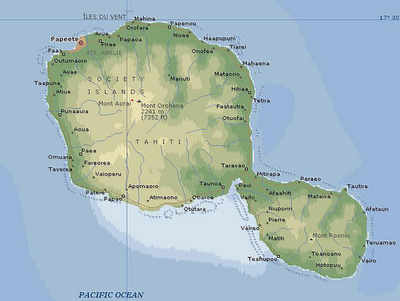 |
After checking out Tahiti Nautic Center, we were hoping to take the boat to Papeete (about 40 miles further) for a few days and then come back to put the boat away. However, the weather was unusually rambunctious this season (likely the result of the strong La Niña that was establishing itself), so we decided to stay put. We needed to go into Papeete to do some paperwork with the officials - Immigration, Customs and the Port Captain/Gendarmerie. We intended to take the bus, but one of our boat neighbors (a local guy named Ludovic) had to go into Papeete for work and offered us a ride. It was a rainy morning, and we got about 1/3 of the way there along the south side road, when we were stopped and told that the road was closed. We had to turn around and take the road along the more rugged north side of the island. It was a beautiful drive, but it made Ludovic very late for work. When we got to Papeete, Ludovic dropped us off in the city center, and we decided to stop in a cafe for a cup of coffee (and more importantly to use the bathroom!). Two cups of coffee cost us about $7 U.S. - that was an expensive pee stop! We spent several hours in Papeete - completed our paperwork with the officials (which was a whirlwind of wild driving with our agent Francesco, who is Italian), did a little bit of sightseeing, checked out the grocery stores and then took the bus back to Tahiti Nautic Center. The earlier problem on the south coast road was cleared up, so the bus took the normal route, but the road is winding and slow-going, and it takes about 1½ hours.
The town of Taravao is about a 20 minute walk from Tahiti Nautic Center, but we could get closer by taking the dinghy up into a creek and tying it to a tree. We went into Taravao to pick up a few provisions and found it to be a nice small town with friendly people. It has some fruit and veggie stands along the roadside, as well as three supermarkets, an ACE Hardware store, a good snack bar where we could get a reasonably priced lunch, a few banks/ATM's, pharmacies - all good stuff - but no laundromat. Grocery prices in Taravao are a little cheaper than in Papeete, so that was good. In general, prices throughout French Polynesia are very high, the highest of all islands in the South Pacific, but if one shops carefully there are some good deals to be had. An evening dinner at a restaurant will cost quite a lot, but we can get a "casse-croûte" (a sandwich made on French bread) or a piece of quiche for lunch for about $4. Of course, if you want a Coke (or "Coke Light") with your lunch, it will add another couple of bucks. Some grocery items are government subsidized (marked "PPN") and pretty cheap, e.g. Laughing Cow Cheese sells for $1.50 for a wheel of 8 wedges. We were delighted to find that fresh locally caught tuna is also subsidized and can be bought for about $6 per pound. Frozen chicken, butter and baguettes are all reasonably priced, but eggs are pricey. Beer is expensive - the cheapest way to buy it is in returnable bottles, and a case of twenty ½ liter bottles (16 oz) runs about $40. Locally grown fruits and vegetables are no bargain, but they're not exorbitant like some of the imported items - we saw a bag of grapes priced at about $17! The grocery stores here are owned by Carrefour, a French company, which ironically also had a bunch of stores in Colombia. They have some good local brands - cereals, canned goods, etc, and those tend to be reasonably priced. We even found some good local brand tortilla chips, but a bag of Rold Gold Pretzels costs $5.
Since we were not taking the boat up to Papeete, we decided to focus on boat chores and cross a few items off our "to-do" list." We wanted to do some varnishing, wax the hull, re-bed some leaky windows, and we had a bunch of laundry to do. Since arriving in French Polynesia, washing machines were few and far between, and when we found them, they were usually expensive, so we did our laundry by hand. Our five-gallon laundry bucket sprung a leak a few weeks prior, so we had gotten a little behind on that chore. Jan had read on the Tahiti Nautic Centre website that they had a washing machine, but her hopes were dashed when Yvan told her that they no longer had it. He told her he knew someone who would do our laundry for us, but the price - about $20/load - was more than we wanted to pay. So, we bought a couple of new 5 gallon buckets at the ACE Hardware and planned to do about five loads of laundry by hand.
And then it started to rain, and it continued to rain day after day. It was impossible to varnish, wax the hull or re-bed the leaky windows. We could catch lots of fresh water to do the laundry, but drying it was the challenge. We had one day when it stopped raining long enough for us to wash a set of sheets and hang them up to dry, but then the wind blew so hard, we were afraid they would either rip apart or blow them out of their clothespins and into the water. It was a frustrating week.
Tahiti Nautic Center (September 17 to 22). Five days before our flight to the US, and with very few items crossed off our "to-do" list, we brought Slip Away into the marina, and it continued to rain. The pieces that Jan wanted to varnish were all removable, and Yvan let her use his workshop which was open-air, so it was well ventilated, but it was also covered so she could varnish while it poured down rain outside. (Our exterior varnish is actually an acrylic urethane, and although it takes longer, it will eventually dry in damp weather.) Rich worked on a number of items - polishing some stainless, pickling the watermaker, flushing out the outboard, and so forth - in preparation for leaving the boat. A couple of days before our departure, the rain abated, and as soon as the sails were dry, we got them off their spars and stored below. We worked together to re-bed the leaky windows, and washed laundry and hung it out to dry. The morning of our departure was again thankfully dry, and we managed to get the cockpit enclosure off and stowed below.
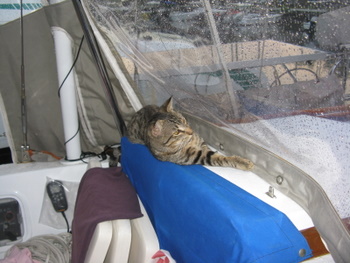 Yvan's cat was very friendly and liked to hang out on Slip Away on rainy days |
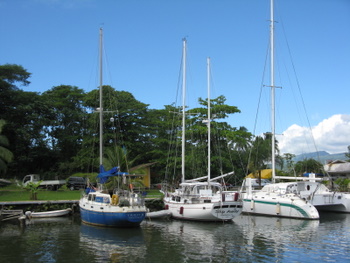 Slip Away at Tahiti Nautic Center - a sunny day and our sails are off - almost ready to go! |
From the marina, we had planned to take a bus to the airport, but with the likelihood of rain, all of our luggage and a tight time schedule, we eventually asked Yvan to call us a taxi. (Our hesitation was the price - the bus cost about $7 US and the taxi fare to the airport was $80.) Our flight didn't depart until that evening, but we needed to run to the Customs office to do some final paperwork for the boat. The taxi was scheduled to come at noon; our bags were packed and we were ready to go at about 11:30 am. Rich looked up at the sky, and it was black and ominous, so we quickly got our bags off the boat and under a shelter where the taxi could pick us up. About 11:45, it started pouring down rain - one of those heavy tropical deluges, but we were dry, and a few minutes later the tax driver pulled into the parking lot. We somehow managed to get our bags into the taxi without getting totally drenched, and we were on our way. Once we were settled in and being driven toward Papeete, we took stock of our surroundings. For the past 7 years, we'd been riding around in old beater taxis in Latin America. We were now riding in a sparkly new Mercedes Benz Van. At least we were getting a nice ride for our money.
| On the way to the airport, as it
continued to pour down rain, our plans changed again. Instead of dropping
our bags at the airport, taking a bus into Papeete, hoofing it out to the
Customs office and back (about a mile from downtown), and taking a bus back to
the airport, we asked the cab driver if he could take us to the Customs office,
wait for us while we did our paperwork, and then drive us to the airport. What's
another $50?! The taxi driver was happy to oblige.
When we arrived at Customs, we went inside and someone directed us to an office on the first floor. We found the door we needed, but it was locked, and there was a sign on it saying that all paperwork for visiting yachts must be completed between the hours of 7 and 11 a.m. Obviously we were not aware of this time constraint. It was now about 2 p.m. Argghhh - what to do? Fortunately, we found a very nice official who spoke English and took us under his wing. He unlocked the office, found our file folder, put the required paperwork inside and left it on the desk for the person in charge to handle. He told us not to worry about it - it would all be taken care of. And, it was. The people here in French Polynesia are so nice. The taxi driver took us back to the airport, where we had about five hours until our flight departed. We were happy to just sit, relax and wait, reading books and surfing the internet to pass the time. The past few days had been hectic and frustrating, but those memories were starting to fade, and we were starting to unwind. We could now look forward to spending the next few months with our family and friends in the U.S. |
|
|
